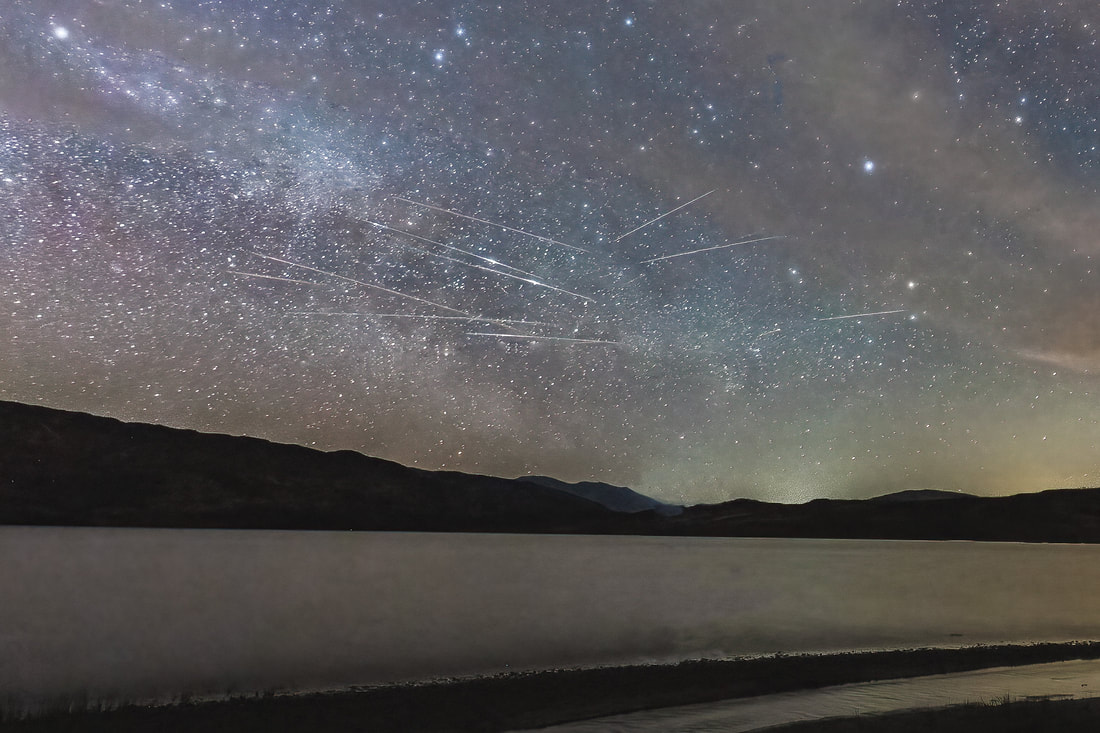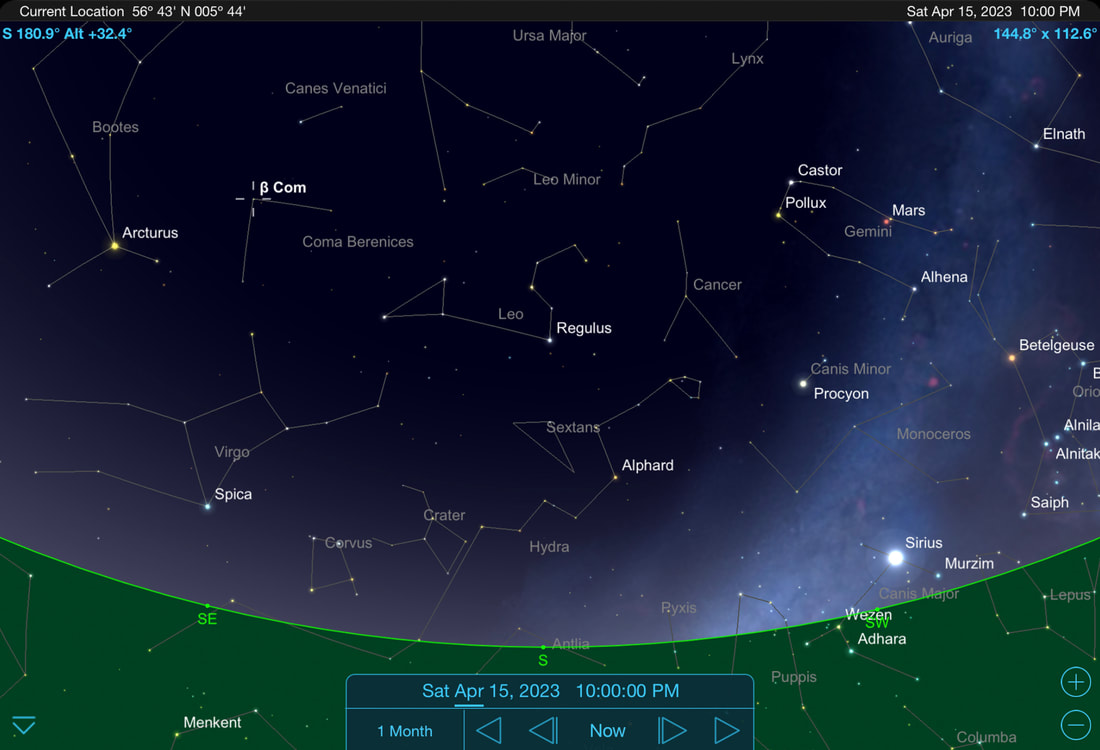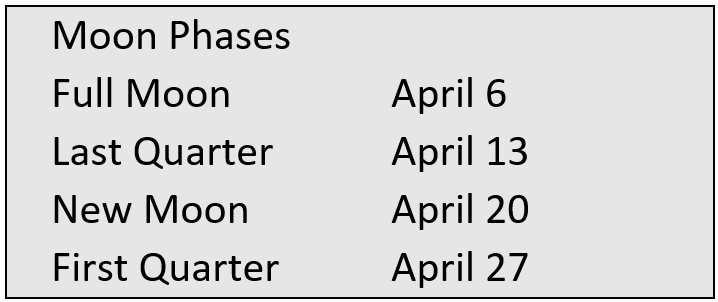|
As the days lengthen and the nights shorten there is still plenty to see in this month’s night sky. The winter constellations will gradually disappear beyond the western horizon as the spring constellations of Leo and Virgo dominate our southern sky. Also, after a gap of a few months, shooting stars return in the form of the Lyrids meteor shower, which peaks on the night of 22-23 April. The ConstellationsThis month, the sun sets around 8:30 pm and the stars and the constellations start to become visible from about 10:00 pm onwards. So, once it is getting dark, look directly above your head and you’ll see the Plough, which is an asterism that is familiar to a lot of people. This makes it an excellent starting point from which to navigate your way around the southern night sky.
Below and to the left of Leo is the constellation of Virgo (The Virgin), with its brightest star Spica sitting down towards the horizon. In some cultures, Virgo is the "Wheat-Bearing Maiden" or the "Daughter of the Harvest” and is depicted holding several spears of wheat in each hand and Spica is one of the ears of grain hanging from her left hand. If you can’t find Spica, try going back up to the Plough and follow the curve of its handle down through the very bright star, Arcturus and then further on down to Spica, which will be low in the sky. Below Virgo, you will see the small constellation of Corvus (The Crow), which ranks 70th in size among the 88 constellations in the night sky. The four brightest stars in this constellation form a square asterism known as the Sail, or the Spica’s Spanker, because two of the stars point the way to Spica. It is an ancient constellation that has been known since the time of the Babylonians. They saw it as a raven, and it was sacred to Adad, the god of rain and storm. To the ancient Greeks, it was a crow sent by Apollo to fetch water. The raven wasted his time eating figs. After returning late, Apollo punished him by throwing him into the heavens. He was also condemned to endure eternal thirst. This is why the crow caws instead of singing like other birds. If you are at a location with little or no light pollution, you may be able to pick out Hydra (The Water Snake), which wriggles along the southern horizon and is the largest constellation in the night sky. Most of its stars are faint, but Alphard, its brightest star, is quite easy to find if you look below and to the right of Leo’s brightest star, Regulus. Alphard is from the Arabic for "the solitary one" as there are no other bright stars near it. You might also be able to pick out the head of the Water Snake. It is an almost square set of four stars about halfway between Regulus and Procyon, the brightest star in Canis Minor, which sits below Castor and Pollux. The Moon
This month’s full Moon is often called the Pink Moon because of the pink flowers – phlox – that bloom in early spring in North America. In other cultures, it is called the sprouting grass moon, the egg moon, and the fish moon. The last quarter Moon is on 13 April and the new Moon (no moon) is on 20 April. This means that a few of days before, on 16 and 17 April, you should see the thinnest of crescent Moons sitting low in the east around sunrise at about 6:00 am. Alternatively, a few days later, on 21 April, you should be able to pick out the thinnest of crescent Moons sitting low in the western sky as the Sun sets. On the following evening, 22 April, a slightly thicker crescent Moon will be higher up in the western sky, sitting below and to the right of Venus. The Moon will be higher still on 23 April, this time sitting just above and to the left of Venus. We have a first quarter Moon (a half moon) on 27 April, and you will find it high in the southern western sky, sitting about halfway between the constellations of Gemini and Leo. A couple of nights before, on 25 April, it will be sitting just above and to the left of Mars. The PlanetsIf, during February, you’ve been looking over to the western horizon as darkness falls, you will have spotted a brilliantly shining Venus getting higher in the sky. This month, the Evening Star doesn’t set until midnight, so it appears really bright against the pitch-black night sky. On 11 April, Venus passes to the left of the Pleiades while in the middle of the month, you will find it near Aldebaran and then on 22 and 23 April, you will find it close to the Moon. Mercury will be just above the western horizon as darkness falls, but as it will be quite faint, it would be best looked for using binoculars or a telescope up to around 10:00 pm, which is when it sets. It will become fainter and fainter as the month progresses before finally disappearing in the brightness of the Sun during the third week of the month. Uranus is sitting not that far from Mercury, but as it is much, much fainter, it will be very difficult to spot. It too will disappear into the dusk glow from the Sun during the second half of the month. Mars is visible for a good part of the night, before setting at around 2:30 am. You will find it high up in the western sky, sitting in the constellation of Gemini. The Moon will be close to it on 25 April. After disappearing for a month, Saturn returns, but this time in the morning sky. You’ll find it rising over in the east at around 5:00 am, moving upwards as the month progresses. Jupiter and Neptune are lost in the Sun’s glare this month. Meteor ShowersAfter several months without any major meteor showers, we have the Lyrid meteor shower this month. It starts on 15 April and reaches its peak on the night of 22-23 April, when its dust particles that originate from the comet Thatcher hit our atmosphere are expected to produce around 15-20 meteors per hour. However, a good number of meteors can usually be seen on the night before and the night after the peak. This year, the peak just two days after a new Moon, making it a great year for spotting shooting stars because the sky will remain dark pretty much all night.
The meteors will appear to emanate from the constellation of Lyra (The Lyre) at a radiant point near Vega, the constellation’s brightest star and the fifth brightest star in the night sky. You will find Vega over in the north-eastern night sky from 10:00 pm, although you don’t need to look there to see meteors as they’ll appear across the whole night sky. Start looking for them from about 10:00 pm as that is when the radiant point is above the horizon and bear in mind that the higher the radiant point gets in the night sky, the greater the number of meteors you should see.
0 Comments
|
Steven Marshall Photography, Rockpool House, Resipole, Strontian, Acharacle, PH36 4HX
Telephone: 01967 431 335 | Mobile: 07585 910 058 | Email: [email protected]
Telephone: 01967 431 335 | Mobile: 07585 910 058 | Email: [email protected]
All Images & Text Copyright © 2024 - Steven Marshall - All Rights Reserved






